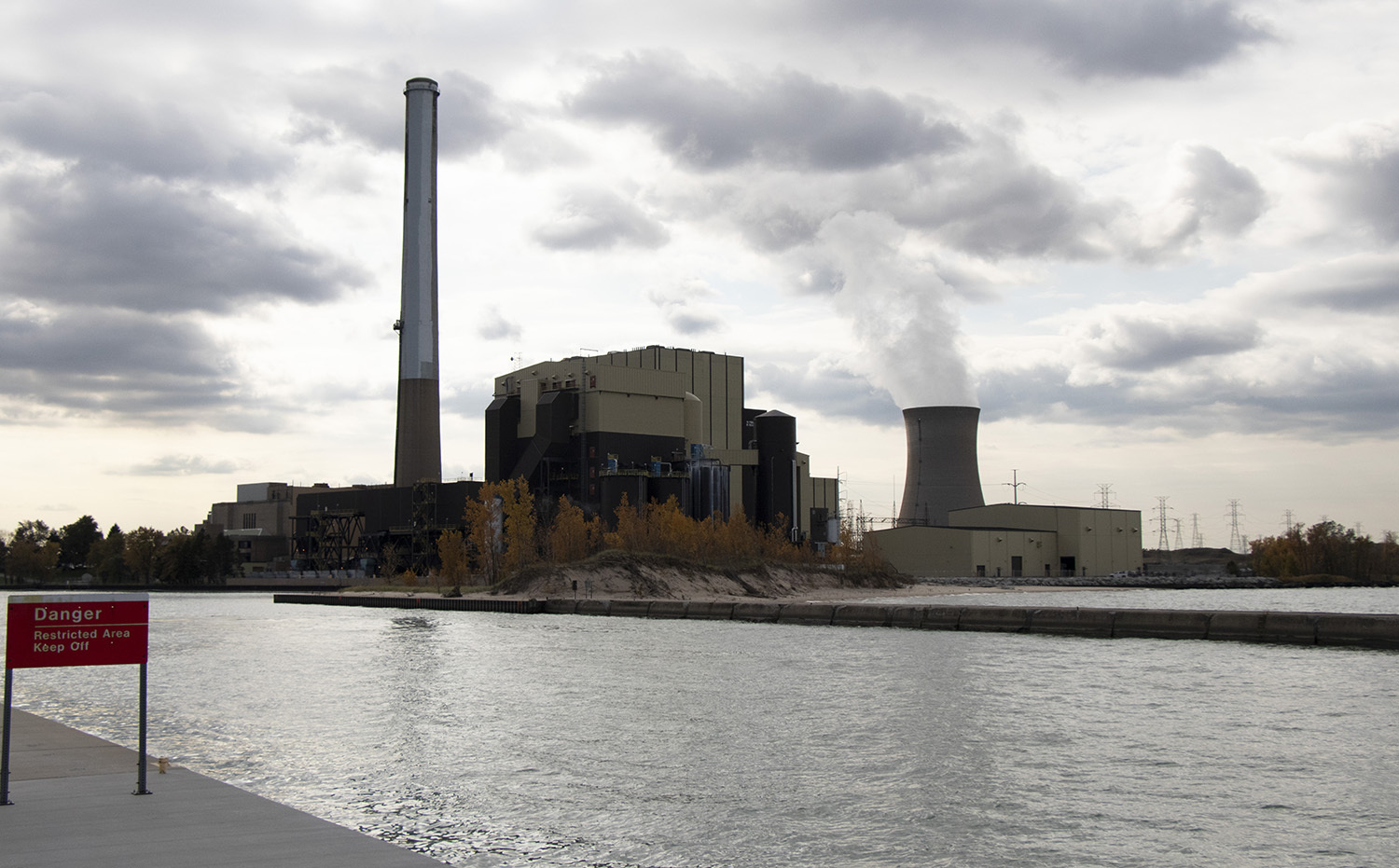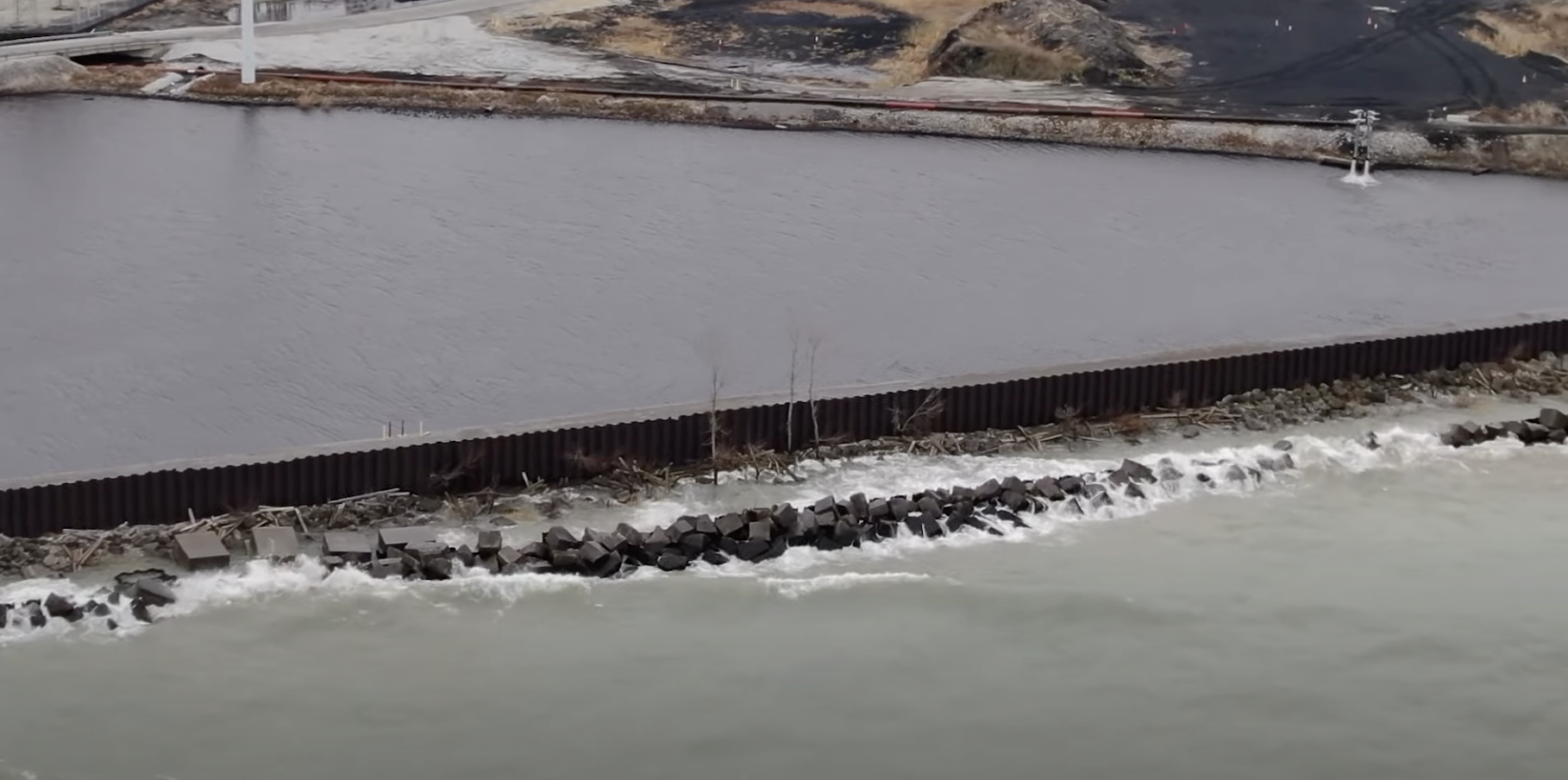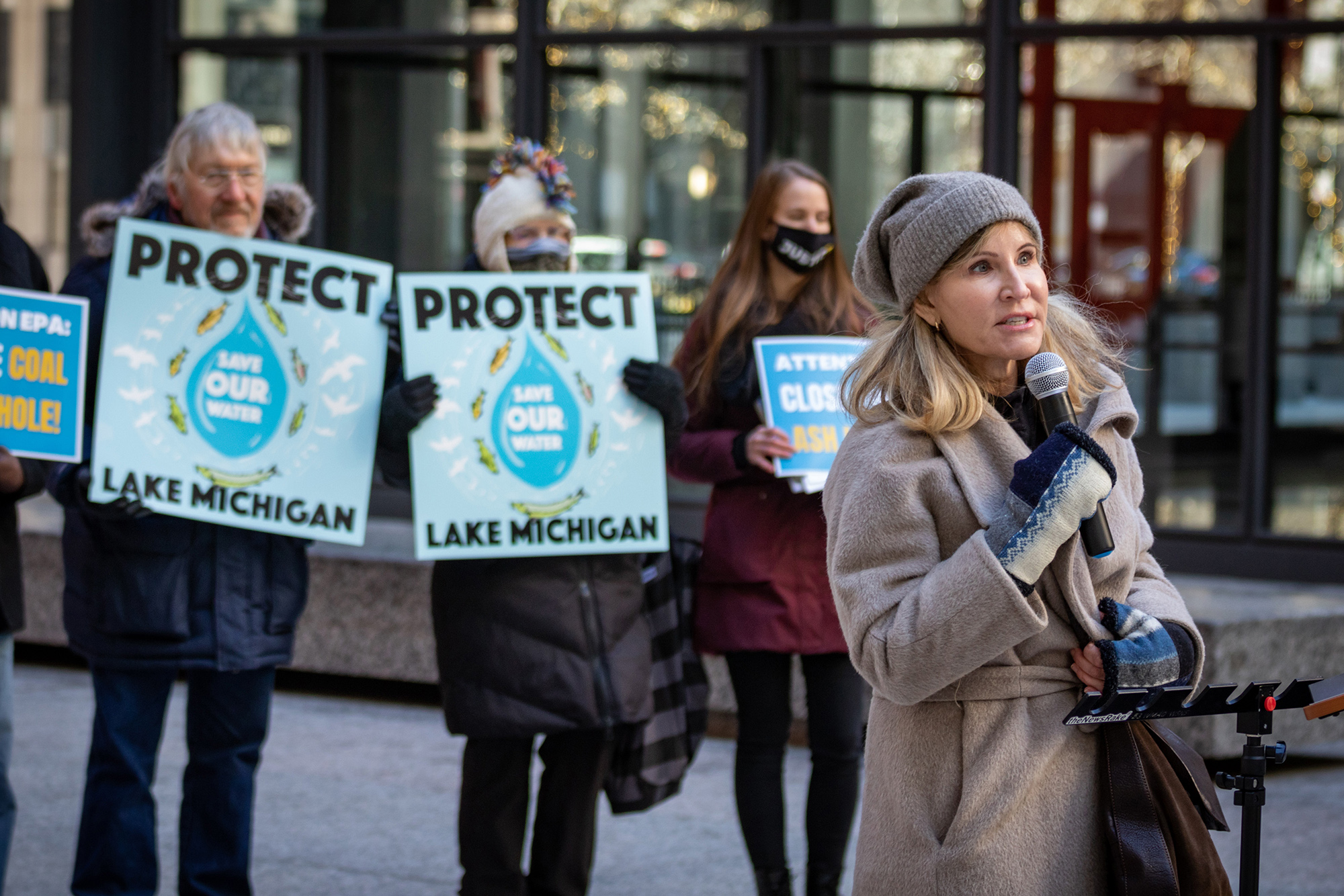News that toxic waste from the recent Norfolk Southern train derailment in East Palestine, Ohio would be shipped to a landfill in Roachdale, Indiana has rung alarm bells with everyone from local residents to Gov. Eric Holcomb, who has ordered testing of the waste for possibly dangerous levels of dioxins.
Yet an equally poisonous substance, present in far greater quantities in communities around Indiana, has received much less attention, with the Indiana Legislature refusing this session to even hear bills that would regulate its safe disposal: coal ash.
The toxic material left over after burning coal for electricity has been found in groundwater at every Indiana facility where coal was burned for electricity, largely as a result of poorly regulated storage that has led to toxins seeping through the soil. It contains harmful chemicals such as boron, lead, mercury and arsenic, and poses the possible risk of blood vessel damage, anemia, neurological and cardiovascular problems, as well as cancer in the skin, bladder, liver and lungs.

Among multiple areas of concern to environmental justice groups and residents, one has risen to the top of the list in terms of urgency: the possible leaking of coal ash from the Northwest Indiana Public Service Co. generating plant in Michigan City into Lake Michigan, which supplies water to 10 million people in Indiana and neighboring states. Seawalls with a limited lifespan are the only barrier between toxic coal ash ponds and the lake, where increasingly high water levels are being fueled by climate change.
“If we have an environmental disaster on the shores of Lake Michigan, it will be irreparable,” Susan Thomas, director of legislation and policy for environmental justice group Just Transition Northwest Indiana, said a news conference in December. “We will never be able to claim back our Great Lakes ecosystem, our beautiful source of wonder and recreation and our drinking water.”
Evaluating a closure plan
NIPSCO’s Michigan City generating station lies on 123 acres of land that stretches along the south shore of Lake Michigan and the western edge of Michigan City.
The plant began operating in 1931. From 1931 to 1950, NIPSCO built steel pile barriers along the border of the property next to Lake Michigan and Trail Creek. Using a mixture of coal ash, sand and soil, it created “made land” behind the walls, which are up to 40 feet deep.

NIPSCO used the made land to expand out toward the lake, building parking lots, additional structures and coal ash ponds.
In 2018, the company announced its plan to close the station and move toward more renewable forms of energy. It began removing coal ash from the station in April 2022, trucking the ash from the ponds to a lined landfill at Schahfer Generating Station in Wheatfield.
The current closure plan includes removing the ash from the five ponds located on the made land but doesn’t include removing the made land itself, even though it, too, is contaminated. That means some ash would stay in place, directly beside Lake Michigan, the drinking water source for around 10 million people.
Since the plant closure was announced, residents have become increasingly concerned about the methods proposed to remove the on-site coal ash, as well as the safety of the site itself.
“NIPSCO was ready to pull the wool over our eyes and leave us with an inheritance that lasts thousands of years. Millions of tons of toxic coal ash waste is fouling our air and water as we speak,” said Ashley Williams, executive director of Just Transition.

In a statement to the Indiana Environmental Reporter, NIPSCO communications manager Tara McElmurry said the Indiana Department of Environmental Management and the U.S. Environmental Protection Agency have approved the cleanup plan as a first step and will determine what additional steps may be necessary to ensure the long-term safety of the community and the environment.
She said the intent of the current work is to address the primary source of the known groundwater impacts in accordance with the environmental regulation in place.
“The primary source is believed to be the ash ponds — 100% of which is being closed by removal,” McElmurry said.
McElmurry said NIPSCO believes having access to clean water and clean air is an essential right.
“Protecting the environment is also a vital component to achieving the long-term economic viability of any community,” she said. “Significant progress has been made in recent decades to improve environmental quality in our region and our state. And, while efforts are ongoing, there is much success to point to. Our current work to remove coal ash material and close our coal ash impoundments at our remaining coal-fired electric generating facilities — which are planned for retirement by 2026-2028 — represents another positive step forward.”
Failing seawalls?
Despite the company’s claims about protecting the environment, residents remain skeptical about how much the company was willing to do to protect residents from pollution.
In June 2022, Just Transition and its partner agencies held a town hall meeting in Michigan City to discuss the results of a report by national environmental law firm Earthjustice on the stability and integrity of the steel sheet seawall that separates the coal ash from Lake Michigan.
The report was commissioned out of frustration. Thomas, who is also the press secretary for Just Transition, explained at the meeting at the Michigan City H.O.P.E. Community Center why the group reached out to Earthjustice.

“As you know, the lake is at record high levels. In the town I live in next to here, we lost a parking lot. In Chicago an entire trail along the lake, swept away,” Thomas said. “When we saw this happening, we thought, ‘Oh my God, what is happening to the pit over by the lake?’ We had people coming to us and saying, ‘We see waves going over there (over the seawall into the coal ash pond).”
Just Transition reported these observations to both IDEM and the EPA, providing drone footage (starting at 1:11) showing the waves cresting over the top of the seawall.
The footage led to a more recent inspection of the seawall by IDEM, but Just Transition still had concerns.
“No one has been connecting the dots at these agencies,” Thomas said.
Earthjustice engaged a Canadian firm, Burgess Environmental, to review the assessments that NIPSCO, IDEM and other agencies commissioned to assess the stability and integrity of the steel sheet pile barriers that separate the ash from Lake Michigan.

The report found three main areas of concern: The steel sheets do not stop the seepage of contaminated water into Lake Michigan; corrosion has and continues to undermine the integrity of the of the walls; and movement of the walls has been and continues to be significant.
“Corrosion of up to 25% of steel sheet thickness has been measured. Ultimately, the steel sheet pile all will corrode and fail if it is left in place,” said Gordon Johnson of Burgess Environmental.
Johnson also pointed out that coal ash causes an accelerated corrosion rate.
“The resulting loss of thickness at the joints of the sheet pile wall increases the overall permeability of the structure, and corrosion at the face of the steel sheet reduces the strength and bending resistance of the barrier,” he said.
Thomas said Just Transition members have had to become citizen scientists because IDEM and the EPA are moving so slowly.
“This is a ticking time bomb. We don’t have time to move slowly,” she said. “We need this cleaned up right now.
“It’s not a question of if the wall will blow, it’s when.”
McElmurry at NIPSCO, however, said the seawalls remain stable and don’t pose an imminent threat. She said an in-depth assessment of the walls rated the structure as “fair,” which means all primary structures are “sound” with some level of expected deterioration but nothing to significantly reduce their ability to provide shoreline protection.
“The seawall structures were intended to provide armoring for the shoreline along the lake and the creek, and they support the overall operations of the generating station,” McElmurry said. “The walls were never designed to provide an impermeable seal from water, and the known groundwater impacts are being addressed by the cleanup work.”
Residents are unhappy with the extent of NIPSCO’s cleanup efforts, but the company is still making them and other customers pay for it, asking the Indiana Regulatory Commission to approve a $20-per-month rate increase across the board.
Just Transition organized an in-person meeting with the Indiana Office of Utility Consumer Counselor in Michigan City to give residents a chance to comment on the rate increase. The OUCC is the state agency charged to represent ratepayer interests.
After the meeting in Michigan City, the agency recommended that the Indiana Utility Regulatory Commission deny the NIPSCO rate increase.
“This is an unjust and unethical hike that shifts the burden away from billionaire industrial consumers (NIPSCO has the highest rate of industrial consumers in the U.S. at 60%) and onto the backs of the residential and smaller consumers already struggling with high costs of energy, fossil fuels and inflation,” Thomas said of the proposal. “The last rate hike shifted the burden off of industry by 19% onto consumers in 2018/19. NIPSCO is trying to turn a profit off of this by qualifying this as capital cost when it's actually an operations and maintenance expense that should be accounted for. Further compounding the problem is that it doesn't cover complete removal of all the toxic ash at the site: only 10% is being excavated while 90% is slated to remain indefinitely on the lake.”
Thomas said other solutions, such as securitization options, could provide for the complete removal of the toxic coal ash without further burdening ratepayers.
“Plus, if the aging steel wall holding it all back gives way, the cost will be far far higher than taking care of this issue now,” she said.
NIPSCO said the rate increase is necessary to cover the $40 million project cost. Indiana and the federal government do allow energy providers to recover “reasonable costs” associated with federally mandated projects.
The utility is proposing to spread the costs through 2032 with a $0.30 increase per month in an effort to reduce the impact on customers.
The commission will announce its decision this summer.
Closing a loophole
Having worked at both the local and state levels to bring awareness to how a coal ash spill could affect Lake Michigan, in December Just Transition tried to appeal at the federal level.
“The two communities where these toxic coal ash pits sit are environmental justice communities, largely Black, largely Brown and low income. We're asking the EPA to help us change the law to protect these communities and to protect Lake Michigan,” Williams said.
In December, the organization and members of other environmental and activist groups delivered a petition with more than 2,000 signatures and a joint letter from 50 organizations in the Great Lakes Region to the EPA Regional Office in Chicago, urging it to make utilities complete a full clean closure of coal ash on their properties.

Williams said the current Coal Ash Rule doesn’t mandate the removal of legacy coal ash. She urged the EPA to close the loophole before a coal ash spill destroys the lake.
“Time is not on our side. With each passing day, we fear, ‘Will this be the day that the seawall finally blows in Michigan City?’ Will our community be the victims of yet another environmental catastrophe that could have been averted?” Williams said.
“Half of our population, the majority of them residents of color, struggle to meet their basic needs. We in Michigan City and our families can't get them (back) nearly 100 years of living and breathing toxic coal pollution. But we refuse to be complicit in the destruction of our futures.”
Pastor Jacarra Williams of New Hope Missionary Baptist Church in Michigan City, spoke to the crowd that gathered when the petition was delivered.
“To not say anything means I agree with everything going on, and I do not agree with it,” he said. “So, I'm here to voice my opinion and say it's time for NIPSCO to stand up and take accountability for their actions. It's time to stand up and do the right thing. This doesn't just affect us in Michigan City, but it affects all of our sisters and brothers because it's not a white issue. It's not a black issue. It's not a Hispanic issue. It's an issue of humankind.”
A delegation of five members delivered the petition to the EPA. Just Transition is waiting for a response.
In the meantime, Just Transition continues to hold legislative action meetings and to urge people on social media to call Senate Environmental Affairs Committee chair Sen. Rick Niemeyer to request bill hearings.
Just Transition and others lobbied for two bills this legislative session that could have helped make the NIPSCO plant in Michigan City more secure. Both bills died in committee.
Senate Bill 399, authored by Sen. Rodney Pol, D-Chesterton, would have established a state policy that favors recycling coal ash and banning it from being stored in a flood plain, touching ground water or to being left in an unstable area.
House Bill 1190, authored by Rep. Pat Boy, D-Michigan City, would have required the removal of coal ash to a lined landfill or for recycling for beneficial use. Air monitoring would be required during the removal process.
“I'd like somebody to listen to my bill and actually make it a priority,” Boy said early in the session. “I've been through it twice. Last year the chair of the committee asked for a summer study and that was denied. They're not looking at it as a problem. They're kind of burying their heads in the sand.”
Instead, lawmakers are ensuring that coal ash regulations are as lenient as they can legally be.
House Bill 1623 would prohibit IDEM from making any rules for a proposed state coal ash permitting program that are more stringent than federal regulations. The bill passed the Indiana House of Representatives and will now be considered by the Indiana Senate.
If the bill passes, any regulations concerning coal ash would most likely have to come from the federal level.
Members of Just Transition said no matter what happens, they will continue to fight for environmental justice across the state.
“The time is now for our communities to not just survive, but to truly thrive,” Ashley Williams said. “To dream of all the things that our city can be, that it deserves to be, without a toxic waste dump in our backyard.”